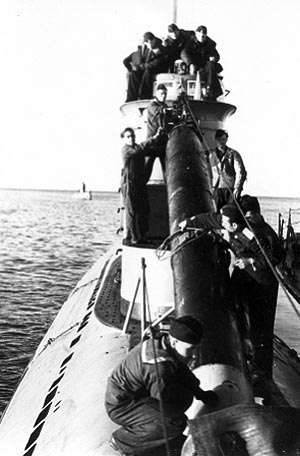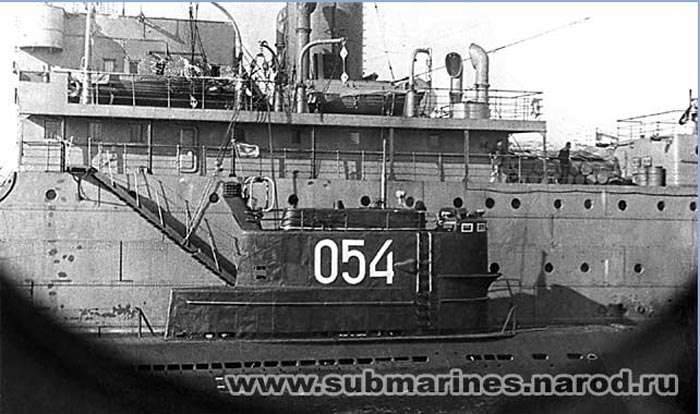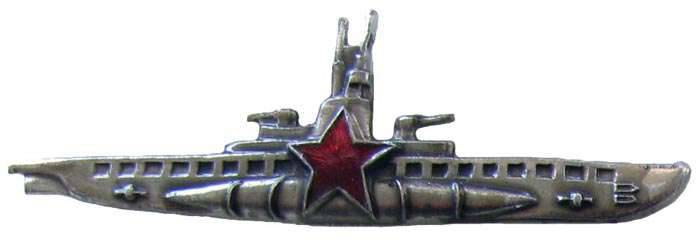Preparation of Soviet submarines for military operations in the 1950-s
It is surprising that mass construction, testing, and inter-theater distribution over fleets there were no disasters, major accidents of submarines of the first generations. This is largely explained by the fact that most of the crews were formed from the personnel of old submarines of the Shchuka, Malyutka type, etc., which already had extensive practical experience in combat training and ensuring trouble-free operation of military equipment. The vast majority of new submarine commanders had experience in combat during the Great Patriotic War. And this experience, especially in matters of management and the struggle for survivability, was harsh and precious.
The crews of submarines launched, as well as those that went out of factory repairs, were processed in the amount of tasks 1-A and 2-A.
Task 1-A: "Organization of the service and preparation of the submarine for navigation."
The task of 2-A: "Control the submarine in surface and submarine positions."
With the arrival at the fleet formations, the submarines were enrolled in the reserve and consistently worked out the tasks of the “Submarine Combat Training Course” (KPL) in full.
The course was divided into 2 stages: preparation of submarines for single and group hostilities:
Task No. 1: Organization of the service and preparation of the submarine for navigation.
Task No. 2: Control a submarine in surface and submarine positions.
Task No. 3: Intelligence off the coast of the enemy.
Task No. 4: Fire training - torpedo (rocket) attacks, mine settings.
Task No. 5: Submarine group actions (in curtains and tactical groups).
During the successive delivery of these tasks, the submarine was introduced: into the campaign (task No. 1), into the second line (task No. 2), into the first line (tasks No. 3 and 4) and into the “combat core” (after working off the entire course in full volume). Submarines of the “combat core” after appropriate checks were allowed to receive nuclear weapons and carried combat duty in remote locations (on remote raids), which was considered the most hated submariners occupation.
In general, a very tense, but well balanced “Course of Combat Training” fit into one year’s campaign; Here, the negative experience of the pre-war period, when the “course” was stretched over two summer campaigns, was reasonably taken into account (as a result, almost half of the submarines of the Baltic Fleet were unprepared for combat by June 22).
In the course of working out the task number 1, the personnel studied the device and the rules of operation of the mechanisms of their management, passed tests and was allowed by order: by ship - to self-maintain their combat posts, officers - to independently manage groups and combat units, and also to carry independently watch in the surface and submarine positions of the submarine (watch officers and watch mechanics).
The commander of the submarine upon entry into command was obliged to immediately pass the exam (or confirm admission) for independent control of the ship; senior assistants commanders were required to acquire this tolerance during the course of working out the tasks of a combat training course. Called to the fleet and young men assigned to service on submarines (and the medical selection was very harsh) a one-year UOPP training course (training units of scuba diving) was mandatory, then sent to the submarines as students, where they were obliged to pass in a two-month period offsets for admission to the combat position in the volume of "combat number books". As a rule, the younger generation entering the submarine had school preparation of 9-10 classes; requirements for sailors surface ships were lower.
Thus, for the 4-year service life, the average submariner mastered the level: in the first year - a specialist of the 3 class, on the second - a specialist of the 2 class and in the third - a specialist of the 1 class ( masters ", moreover, not all). This system was strictly regulated and fully justified itself. Its subsequent violations in the form of shortening the service life to three, and then to two years, and contractual service ultimately led to a sharp increase in accident rates and other negative phenomena.
Features of the training of submariners of the period manifested themselves in the torpedo training conducted under tough requirements: the submarine shot the entire course of task No. 4 (from the element 4-B - the attack of a single ship going on a direct course to 4-I - the attack of a high-speed highly guarded target on zigzag) in strict sequence. She was not allowed to the more complex types of attacks, until she achieved a test for “good” or “excellent”. Shooting was carried out only by a complete set of torpedoes of volley (without the negligent designation “bubble”, as it entered the system later).
Therefore, it often turned out this way: by morning, the submarine unloaded the fighting torpedoes from the vehicles, loaded 4 practical torpedoes, went to sea and attacked the “enemy” with a full salvo, and on returning to the base immediately restored full ammunition; no references to "later" were allowed. In the next exit repeated the entire cycle of loading and unloading. The author dares to assure: in the most intense weeks the submarine overloaded torpedoes to 24-32. And there were practically no accidents with weapons!

Loading torpedoes through a torpedo loading hatch
The final attack (combat control 4-I) was framed by draconian conditions: the attacking submarine had to detect a detachment of warships at the ultimate ranges, move closer covertly within the “critical course angle”, also covertly break through artillery, hitting self-guided torpedoes 1-2 closest escort ship and attack the main target (usually a cruiser) with an 4-torpedo volley, achieving a “hit” (passing under the target) at least two torpedoes. Separate violations of stealth attacks — the detection by the “adversary” of short-duration radar or periscope pulses, the detection of the submarine’s “before” the release of torpedoes, or the miss of a volley by the sonar — led to an unambiguous assessment of “unsatisfactory”.
A very typical confirmation of such an order was the final attack in 1958 of the Pacific C-150 submarine (commander-in-chief 3 of rank V. Kiriyenko) of a detachment of ships consisting of a cruiser and four destroyers that went from Kamchatka to Peter the Great Bay. The attack was “given”: the commander of the squadron of surface ships was Rear-Admiral G. Chernobay, Commander of the submarine forces of the Pacific Fleet Rear-Admiral L. Hiyainen.
The submarine C-150 (the commander was ill, had a temperature of 39 ° C; there was no condescension to this) successfully attacked the military bridge, hitting a homing ship and two torpedoes cruiser. But she received a rating of "unsuccessful": before laying on the "combat course" the commander briefly raised the periscope and was spotted (and should have been at a depth of at least 30 meters). Back in the sea, the submarine received an RDO: “I will deal with your approach to the base.”
With the approach of the submarine to the pier, Rear Admiral Hiyainen made the most severe review: he literally crawled through all the holds and enclosures, and then gloomily examined the “chicken underwater army” and grunted: “I do not punish you just for the fact that the boat is clean ".
And the final grade "unsuccessful" remained. She crossed out all annual combat training; the submarine from the "red" got into the "black" list and was allowed to re-shoot (final) only a year later! Throughout the ensuing winter, staffers and political workers at all sorts of naval assets and conferences would certainly “wipe their feet” about the ill-fated C-150 and its commander.
Before this failed attack, the submarine had completed all the combat exercises as excellent; All ratings have been canceled. That was “Papa Hee,” as L. Hiyaynen, who fought on submarines of the Black Sea Fleet, was called the brave submariners of the post-Stalin period with the respectful jade.
The experience of “science to attack and shoot” was invaluable. It was transmitted to the commanders of the famous department theorists of the leading commanding classes (Navy Volks), Lontsikh and Doronin, who deserved an unforgettable memory. A truly precious practical guide for submarine commanders, especially in the case of “acoustic” attacks of a high-speed maneuvering protected target, was the so-called Rulyuk tablet (the commander of the formation, later the rear admiral), on which not one generation of commanders of diesel submarines mastered the complex art of acoustic attacks. However, other fleets had their Ruleks.
The struggle for vitality was practiced daily and without hack. Again, the uncompromising and tough experience of wartime submariners came in handy. During the Great Patriotic War, almost all submarine commanders were still young officers, but they already had the experience of “fighting for a ship” in difficult, and sometimes in extremely difficult, combat conditions.
The golden rule was to work out the “primary events” daily, as a result, every submariner knew his compartment “better than his mother”, and was worn by a bullet in pitch darkness.
During the primary measures and emergency shut-off exercises, the commander of the compartment commanded (as a rule, the foreman or midshipman), while the “gentlemen officers” acted in the position of “privates” (including the submarine commander).
The reader would see how many fingals and bruises were on the commander's face, when the light turned on under the sailors chuckles! But the chuckles and giggles were not evil: they did not undermine, but strengthened the authority of the commander and the soldering of the team: “the commander can do what I can do.”
How sometimes the struggle for survivability and underwater unsinkability of a diesel submarine looked, can be understood from the following ancient episode that took place in the Pacific Fleet.
In August, the 1959 of the year, the C-331 submarine, entered the deep-water area to inspect the hull when diving to the working depth. She was accompanied by a ship-controller — the C-150 submarine, on which the narrator was the first mate, who observed the whole picture from the bridge of her submarine.

C-331 at the side of the floating base "North"
The submerged C-331 was first-line; no special insurance (in the form of a rescue force detachment) was required. The submersible boat was delayed at all depths, multiples of 25-30 meters, inspected the outboard reinforcement, gave the coded signal "depth ... meters, everything is in order" and sank further. The submarine controller was kept at the acoustic communication range and received coded signals. Everything went without a hitch.
But at the last test depth of 170 meters, the submerged submarine did not give a signal. Then what happened was that the people who were watching from the boat-controller had hair bristling: suddenly the C-331 flew out to the surface of the sea with a candle: the entire hull of the submarine from 1 to 6 compartment was in the air (and this is 60-65 meters) and only the seventh compartment and the stern rudders and its screws were still in the water. With the same candle, the submarine went under water and soared up again (already in the fifth compartment), sank half-light, then appeared on the surface (along the wheelhouse), then fell on board, straightened and rocked on the surface of the sea. People appeared on the bridge.
The C-150 insurer approached voice communication and asked: “Do you need help? Is towing necessary? ”They responded with a semaphore from the emergency submarine:“ The boat is de-energized, we run the diesel on the propeller-generator, we will reach it ourselves ”. The submarines went to the base.
Well, and inside the boat? Here is what the senior assistant to the commander of C-331, Captain 3 of the rank of A. Lutsky (later Rear Admiral), said:
- Immersion went according to plan. As I should have done, I stood under the dismounted lower jack hatch and watched the conning tower fittings, gripping a vertical ladder. And suddenly at the depth of 170 meters over the ears, like a whip, a sharp whistle hit, an impenetrable fog instantly appeared. The boat jerked up, I was thrown by the breast onto the vertical ladder, and I was temporarily "cut out" from the blow. But before that, he managed to remember the commander's gesture: “Blowing the ballast!” There were no voice commands, and this is useless. I do not remember anything further, except that my legs jerked up, I woke up when I was jerked down again and I was in an upright position.
As it turned out later: the gland of one of the valves of the low-pressure air column located on the ceiling was torn apart. It is our happiness that the gland vomited, and not the entire valve stem. A water jet as thick as a finger at such a depth is capable of piercing a human body.
When the ballast was accidentally blown up, the submarine flew up to the height of the throwing trim to almost 90 °. All the electrolyte of the batteries was poured in the pits, emergency protection was triggered, the lights went out ... All personnel fell down to the bulkheads. But, as it turned out, there were no maimed. All kinds of safes, drawers and portable devices were reliably installed in a traveling manner, this saved many people from injury. In short, the high organization of the crew affected. Such a "happy end".
By the middle of the 1950-s, and later, it became particularly fashionable to work out the struggle for the survivability of ships in "conditions of use of atomic and chemical weapons by the enemy." This "struggle" at times acquired grotesque forms. Not done without the oddities inherent only in Russian reality.
The main "alphabet" of the sailor was considered "Memo". She should have known by heart. In the course of the "anti-nuclear campaign", inspectors from all sorts of headquarters rained down on ships with peas. Sometimes the knowledge of these inspectors was more skinny than the ill-fated "Memo". Often there was such a vaudeville: the inspector arrives at the ship, accompanied by the ship service, he is importantly marching along the deck. Such representatives, as a rule, did not descend to the lower rooms. Looks important, looks responsibly. State man! I saw some piece of iron and suddenly poked at the nearest sailor: “Atomic bomb explosion on the forecastle! Your actions?"

The effect of such “introductory” has always been impressive: the inspector, with a look offended by the state, marched to the pier and hurried to report at the instance - “on this ship the personnel was not prepared!” And the ship (and boat, too) authorities made a formidable face and shook their fists before the sweaty physiognomy of the sailor: “Oooh, you, p-bungler!”
Since the instructions on PAZ and PKhZ (anti-atomic and anti-chemical protection) both in the army (battalion, company, platoon) and in the fleet were issued according to a single method, the fleet (destroyer, minesweeper, submarine) acted in accordance with the same unified method. The final, and therefore the most important element of task No. 2 (“anti-atomic and anti-chemical protection of the submarine”) was played according to the same scenario: the submarine was at the pier, a sudden raid aviation the enemy, which dumps on an unfortunate submarine either an atomic bomb, or a bucket of mustard-lewisite. In response to these vile actions of the enemy, a “chemical alarm” is announced on the boat, chemical reconnaissance agents hung up with dosimeters and reagent boxes come out of the hull and outlines the “infection sites” with chalk. After them, in chemical kits, armed with gangs, mops and long-stick brushes, they climb along staples like clumsy crabs, ODO and DDO (main and additional degassing compartments) and carefully rubbed “infected places” with outboard water.
As a rule, the father-commander and the host task flagship chemist are on the bridge (of course, without gas masks) and boss shout: “Well, you are there! Do not fall overboard! ”You can, of course, move away from the pier, dive and wash away all the“ this rubbish. ” But such an initiative contradicted the “method” and was not encouraged.
Training submarine commanders carried out very hard. And this, of course, affected the school of wartime. The officer, who was admitted to independent control and took command of the submarine, received the right to wear the breastplate “Submarine Commander” - a silver-plated old “pike” with a star in the middle. This badge was worn with particular pride and valued above orders; he drew respectful respect from all sailors.

The officer appointed to the position of senior assistant (assistant) of the submarine commander was obliged to take a theoretical and practical examination for admission to the independent control of the ship of his project in the 6 month period.
In the theoretical part, the thirsty admission was supposed to pass:
- the flagship navigator of the compound - the entire naval theater for the tactical range of the submarine: draw a plan of any bay, strait, etc., as a souvenir. with all navigational hazards, fairways and depths; To perform a control navigation pad with all sorts of tricky things, to solve an astronomical problem in a normative time frame.
Usually the flagshturman didn’t bother himself with brilliant awareness: he simply took a map, compared and filtered through his teeth: “And here you didn’t put an underwater pebble. Do not know. Go ... ";
- to the flagship mechanical engineer (deputy commander of the connection on the electromechanical part): draw out any ship system (which is sometimes more complicated than any transistor circuit) for memory, make an express calculation of the stability and buoyancy of the boat in various emergency compartment flooding options, etc .;
- to the chief of intelligence: discard tactical and technical data of the main ships of the potential enemy to memory, classify carriers according to the operating parameters of their radio electronic systems (radar and sonar stations);
- The rest of the "flagship dragons" - about the same, plus the latest manuals and instructions.
Having handed over the theory, the thirsty descended to someone else’s compound, where he was used in the “Negro” mode, learning the science of ship control at sea (as a rule, in autonomous navigation, with the performance of regular or alternate duties). Thus, the practical part was confirmed by the painting of foreign commanders. And only after this, the subject arrived at his native brigade and presented a “test list”, which was marked with many signatures. The admission was announced by order of the fleet commander.
But that was not all: the officer was heading for the Navy Volga, and only after completing the one-year training program did he become a full-fledged submarine commander.
It was an era when the position of "ship commander" was a matter of particular pride and was the cherished goal of every ship officer.
Information